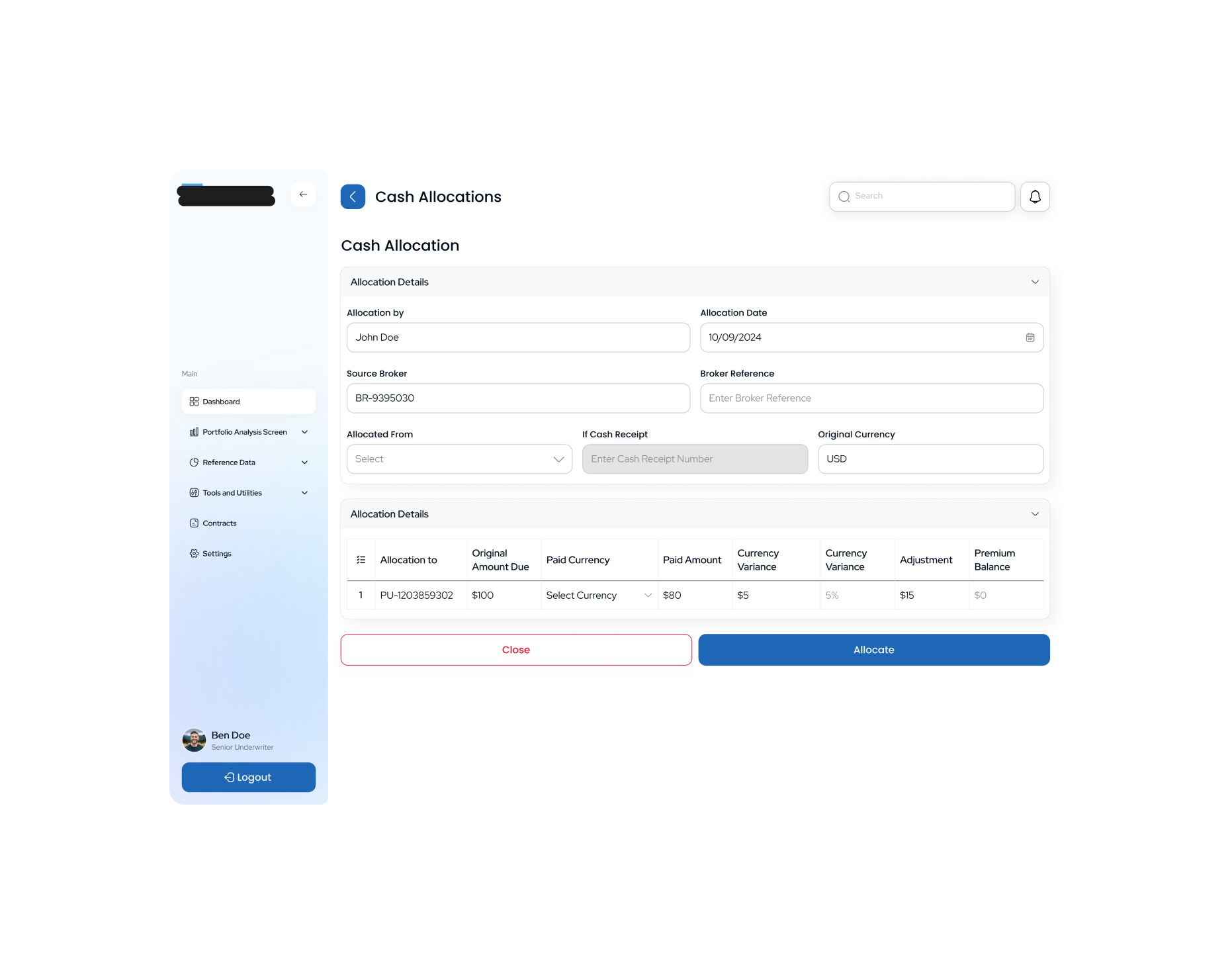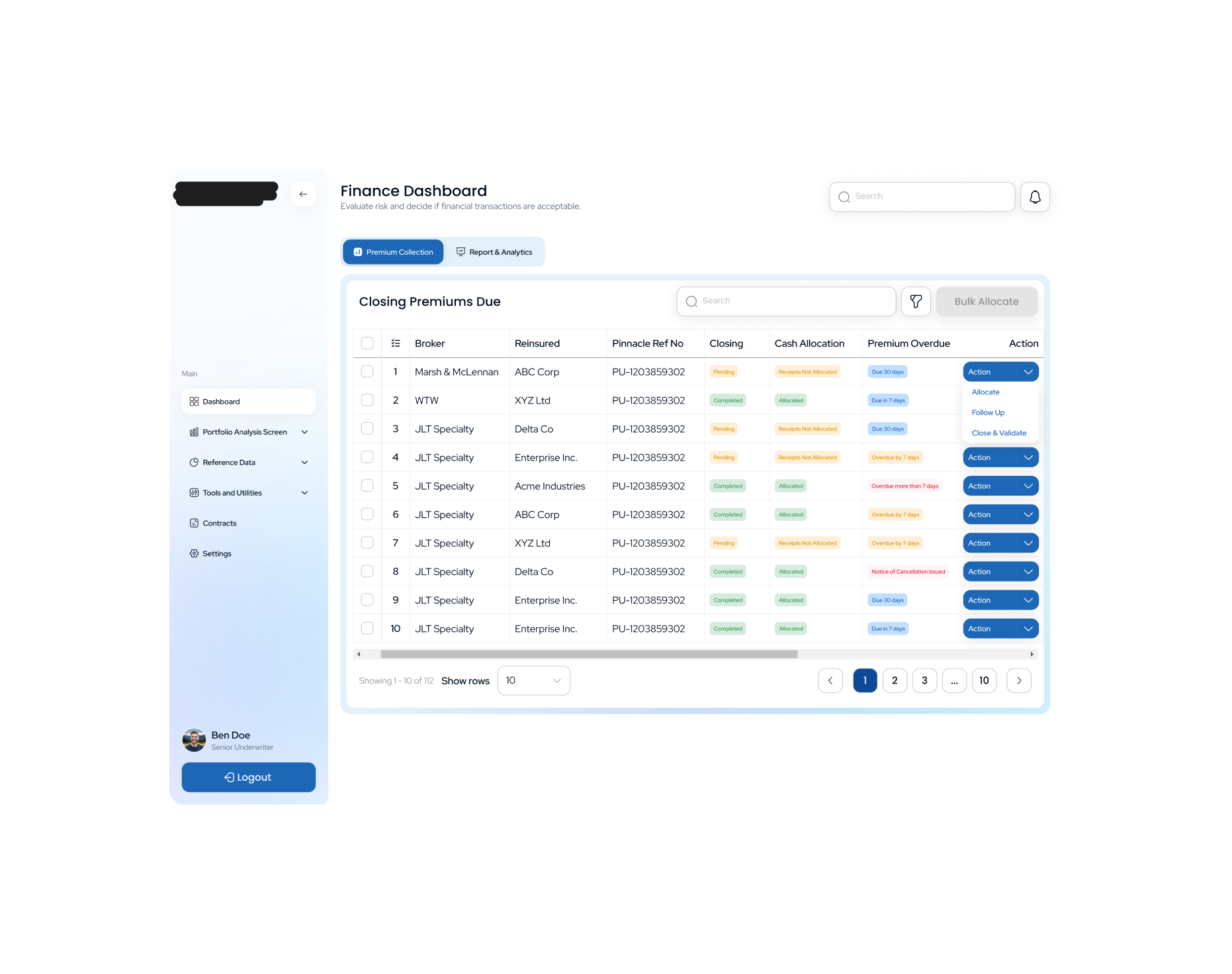Enhancing Internal Reinsurance Workflows
Reinsurance Underwiting Platform
Project Type
Product Discovery
Team Size
7
Deliverables
Stakeholder Interviews, Product Research, User Journey Mapping, Cross-Functional Collaboration
“It just slow and very outdated really… (the current platform) just isn’t ideal; we’d really love to see what you can do.”
— Senior Underwriter, on the current platform
The Problem
When we started, the users were struggling with:
Inefficient workflows: Submission and pricing of contracts were currently handled manually, making it hard to complete tasks.
Data inaccuracies: Lack of error handling and review steps in the Schedule of Values (SOV) and submission data slowed processes.
Limited tools: Critical tasks like compliance checks, financial reporting, and claims management processes were disjointed and inconsistent.
From a business perspective, these issues translated into longer turnaround times, reduced productivity, and missed revenue opportunities. The stakes were clear: if we could simplify workflows and provide users with the right tools, the platform could transform how the different teams operated.
The Challenges
How can we reduce the development effort while creating such a complex platform?
How can we simplify workflows for users performing intricate underwriting and pricing tasks?
How can we address the highly technical Needs of users as industry outsiders?
How can we account for different fringe cases that may be encountered?
How can we ensure consistency across workflows that span underwriting, compliance, claims, and finance?
How can we simplify workflows for users performing intricate underwriting and pricing tasks?
Stakeholder interviews were initially conducted over 2 weeks at the beginning of the discovery sprint.
The Process
Understanding the users
The Reinsurance Underwriting Platform served diverse stakeholders, including underwriters, finance teams, and compliance officers, each with distinct needs: underwriters required streamlined submissions, finance teams needed accurate premium and claims handling, and compliance officers relied on automated regulatory checks. Understanding these intersections allowed us to design a cohesive platform that addressed specific needs while ensuring seamless integration across roles.
We started with stakeholder interviews, sitting down with underwriters, finance managers, and compliance officers to uncover their biggest pain points. We found it important to capture insights as direct quotes:
“I’m constantly jumping between tabs to get basic tasks done.”
“The SOV process is tedious on (the current platform); it’s easy to miss errors that come back to bite us.”
Stakeholder feedback is captured live using AI transcription, which is then converted into an "Idea" ticket on Jira Product Discovery. Each ticket includes effort ratings (designer, developer, etc.) and impact ratings (business, underwriter, finance, administrator, and UX).
Effort vs. Impact Scoring: Effort scores estimate the resources needed, while impact scores measure the benefit to various stakeholders. Items with high impact and low effort are prioritized for development, while low impact and high effort items are deprioritized.
Why It’s Valuable: This system ensures that work is prioritized based on clear, measurable criteria. The creation of these prioritized tickets early on facilitates creation of feature maps, user flows, as well as setting a foundation for the product backlog.
Features and User Experience
The Reinsurance Underwriting Platform served diverse stakeholders, including underwriters, finance teams, and compliance officers, each with distinct needs: underwriters required streamlined submissions, finance teams needed accurate premium and claims handling, and compliance officers relied on automated regulatory checks. Understanding these intersections allowed us to design a cohesive platform that addressed specific needs while ensuring seamless integration across roles.
The update of the platform involved integration of many modern technologies to automate certain repetitive tasks. These APIs significantly reduce the task load for underwriters and other users, but dues to the nature of the work it is essential that the user has the ability to control and intervene at various points that these APIs are implemented. Additionally, As the users spend a significant amount of their time working with excel in the current state of the platform, certain quality of life features present in excel must be accounted for such as list views and search features. As a result, manual user overrides were implemented at various points in the workflows.
Prototyping
Based on the priority score, high fidelity prototypes were created and presented to the client in a series of workshops. These workshops acted as a second pass to ensure that all necessary functionalities appear at different steps of the processes and to capture high level UX feedback.
The Jira product discovery board was maintained and continuously updated, with delivery tickets trafficing work to the designers and also recording backlog items for future sprints.
















